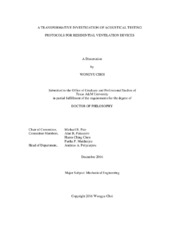| dc.description.abstract | Mechanical ventilation plays a crucial role for indoor environment quality as built environments pursue tighter and energy efficient constructions. Therefore, stringent guidelines for proper ventilation are imposed on residential buildings in the U.S, which includes International Energy Conservation Code, ASHRAE 62.2, and state regulations. Likewise, certification and verification programs for residential ventilation devices, such as Energy Star and Home Ventilating Institute (HVI), are continuously mandated by governmental agencies along with usage of associated testing standards such as ANSI, ISO, AMCA, and HVI. Because of the wide interest surrounding standard testing, certification, and verification programs, precision and accuracy by improved testing methodologies are necessary.
In this work, three primary objectives are formulated to address the necessity for improving testing protocols for residential ventilation devices, namely (1) performance evaluations of residential ventilations devices as functions of timelines and energy codes, and (2) identifications of challenges and issues arising from using existing testing methodologies, and (3) introduction of revised and improved testing methodologies to overcome challenges identified. In an effort to address these three objectives, this study presents (1) performance evaluations of large quantity of residential bathroom fan testing data over a decade, (2) improved testing methodologies for precise background steadiness evaluation, (3) uncertainty analytics along with improve metrics and criteria for better fan-acoustic testing quality, and (4) implementation of revised psychoacoustic loudness models as an update to an existing loudness calculation procedures.
Major overall conclusions from this study are that (1) fan acoustic and energy performances have improved over the last decade, specifically by 50% reductions in loudness and 25% efficacy increase which is a ratio of fan volume flow rate and power consumption, (2) usage of external background noise signal can benefit the background steadiness evaluations by the aid of acoustic transmission signature analysis, (3) a combined use of conventional background-noise uncertainty and SNR analytics in terms of theoretical zero loudness can better tell the background impact to loudness rating, and (4) an update to the conventional loudness calculation can be made by the revised psychoacoustic model, which also address limitations on the conventional loudness, which includes a lack of tonal-component implementation to loudness and outdated equal loudness contour. | en |


